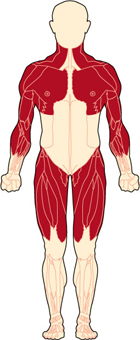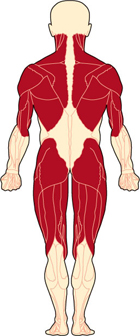
|

|
|
In the early stages, Duchenne MD affects the shoulder and upper arm
muscles and the muscles of the hips and thighs. These weaknesses lead to
difficulty in rising from the floor, climbing stairs, maintaining
balance and raising the arms. |
What is Duchenne muscular dystrophy?
Duchenne muscular dystrophy (DMD) is a genetic disorder characterized
by progressive muscle degeneration and weakness. It is one of nine
types of muscular dystrophy.
DMD is caused by an absence of dystrophin, a protein that
helps keep muscle cells intact. Symptom onset is in early childhood,
usually between ages 3 and 5. The disease primarily affects boys, but in
rare cases it can affect girls.
What are the symptoms of DMD?
Muscle weakness can begin as early as age 3, first affecting the
muscles of the hips, pelvic area, thighs and shoulders, and later the
skeletal (voluntary) muscles in the arms, legs and trunk. The calves
often are enlarged. By the early teens, the heart and respiratory
muscles also are affected. For more about DMD symptoms, see Signs and Symptoms.
Becker muscular dystrophy (BMD)
is a milder version of DMD. Its onset is usually in the teens or early
adulthood, and the course is slower and less predictable than that of
DMD.
What causes DMD?
Duchenne muscular dystrophy was first described by the French
neurologist Guillaume Benjamin Amand Duchenne in the 1860s, but until
the 1980s, little was known about the cause of any kind of muscular
dystrophy. In 1986, MDA-supported researchers identified a particular
gene on the X chromosome that, when flawed (mutated), leads to DMD. In
1987, the protein associated with this gene was identified and named dystrophin. Lack of the dystrophin protein in muscle cells causes them to be fragile and easily damaged.
DMD has an X-linked recessive inheritance pattern and is passed on by the mother, who is referred to as a carrier. For more about the way gene mutations cause Duchenne dystrophy, see Causes/Inheritance.
What are DMD 'carriers'?
DMD carriers are females who have a normal dystrophin gene on one X
chromosome and an abnormal dystrophin gene on the other X chromosome.
Most carriers of DMD do not themselves have signs and symptoms of the
disease, but a minority do. Symptoms can range from mild skeletal muscle
weakness or cardiac involvement to severe weakness or cardiac effects
and can begin in childhood or adulthood. For more, read Females and DMD in Causes/Inheritance.
What is the life expectancy in DMD?
Until relatively recently, boys with DMD usually did not survive much
beyond their teen years. Thanks to advances in cardiac and respiratory
care, life expectancy is increasing and many young adults with DMD
attend college, have careers, get married and have children. Survival
into the early 30s is becoming more common, and there are cases of men
living into their 40s and 50s. For more about living with DMD, see Medical Management.
What is the status of DMD research?
MDA-supported researchers are actively pursuing several exciting strategies in DMD, such as gene therapy, exon skipping, stop codon read-through and gene repair.
Human clinical trials are under way for some of these strategies. For
an overview of DMD research strategies and the latest research news, see
Research.




